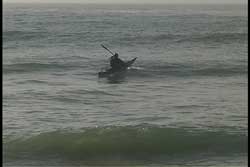 Here are the step by step considerations for a successful
back in surf landing.
Here are the step by step considerations for a successful
back in surf landing.Back In Surf Landing
By Wayne Horodowich
Over the years I have found a number of kayakers that don't like having their backs to the incoming waves during a surf landing. In Hawaii the locals say, "Never turn your back to the ocean". As a result of these feelings, a variation of the "In Out Surf Landing" has been developed that allows the paddler to face the waves while landing. See USK article, "In Out Surf Landing".
"The Back In Surf Landing" follows the same concepts as the "In Out Surf Landing", but the kayaker paddles to shore in reverse. It is important that the kayaker have a good supportive back stroke if they want to rely on this back in landing. See USK article, "Supportive Back Stroke". One of the greatest advantages for using this landing method is you are counteracting the force of the incoming waves while doing a forward stroke. In the standard in out landing you counteract the force of the waves while paddling backwards. I believe most people feel greater control when they take a wave head on instead of backing into it.
The greatest difficulty in backing in toward shore is the reduced speed of most paddlers when paddling backwards. In addition, many paddlers have difficulty in keeping a straight course when paddling backwards. That is why I highly recommend the supportive back stroke, which is really a supportive reverse sweep stroke. Once you master this stroke, back in landings will be a delight. A fabulous instructional sequence for the supportive reverse sweep stroke can be found on the USK Video Volume 3 "Beyond the Cockpit" featuring Derek Hutchinson.
 Here are the step by step considerations for a successful
back in surf landing.
Here are the step by step considerations for a successful
back in surf landing.
As you approach the surf zone you are watching the area where the waves are breaking. When you get close to the break zone you want to quickly turn your kayak so your bow is facing the incoming swells. An extended paddle forward sweep stroke will turn you quickly. See USK article, "Extended Paddle Forward Sweep Stroke".
When ready, paddle backwards to the landing spot you picked out on the beach. You will have to look over your shoulder regularly to be sure you are paddling straight in. Of course you have raised your rudder or skeg before you started your landing process.
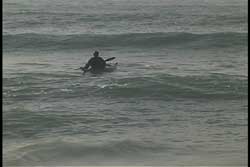 Let the swells pass under you as you get closer to the break
zone and paddle forward as needed to keep from getting surfed in. After a swell passes under your kayak, follow it in, keeping in mind you don't want to be where the wave
is breaking on you.
Let the swells pass under you as you get closer to the break
zone and paddle forward as needed to keep from getting surfed in. After a swell passes under your kayak, follow it in, keeping in mind you don't want to be where the wave
is breaking on you.
The closer you get to the break zone the taller and steeper the swell becomes. Soon it will be a breaking wave. A good forward stroke will get you up the steepening swell. The ideal location is to be where the wave is almost ready to break, but you can still paddle over it.
If you do not paddle forward over a steepening wave, gravity will pull you down the face of the wave and you will be back surfing in front of that wave, which will soon be a breaking wave.
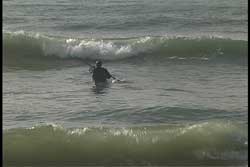 As soon as the steep wave passes under the kayak the paddler
charges backwards toward shore. Since this is the beginning of the breaking
area the paddler should get through it before the next wave comes in.
As soon as the steep wave passes under the kayak the paddler
charges backwards toward shore. Since this is the beginning of the breaking
area the paddler should get through it before the next wave comes in.
This is where that supportive back stroke is important. You want speed, good directional control and support from your paddle while going backwards in an area that usually has confused waters.
To see if your back stroke is reliable, try a back sprint on flat water. If your kayak begins to turn think about the supportive sweep stroke as your primary back stroke. Practicing straight back sprints, of at least 50 yards on flat water, is a good training exercise prior to entering a surf zone.
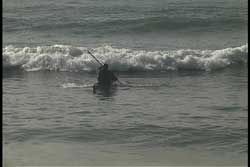 As the kayaker paddles toward shore he or she is watching the
next wave come toward them. Since the kayaker is past the breaking point, they
will now have to deal with the whitewater waves, which is a result of the
wave breaking. These whitewater waves will soon catch up with you in the zone regardless of your speed.
As the kayaker paddles toward shore he or she is watching the
next wave come toward them. Since the kayaker is past the breaking point, they
will now have to deal with the whitewater waves, which is a result of the
wave breaking. These whitewater waves will soon catch up with you in the zone regardless of your speed.
The faster you can paddle backwards, the faster you get to shore. The less time in the surf zone means the fewer waves you have to encounter in your landing. Since the likelihood of a capsize is greater when the wave is hitting you, your odds of going over increase with the more waves you encounter. You can see the benefit of having a fast back stroke.
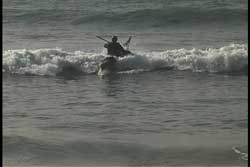 The paddler still races backwards toward shore knowing one
of the whitewater waves will catch up to the kayak. The more support you have from your back stroke the better your chances of staying upright when hit by the whitewater wave.
The paddler still races backwards toward shore knowing one
of the whitewater waves will catch up to the kayak. The more support you have from your back stroke the better your chances of staying upright when hit by the whitewater wave.
Remember not to lift your paddle above your head if there is big whitewater. It is best to be spearing your paddle into high waves to get the least amount of force on the paddle from the wave. As larger waves hit your body, a slight lean forward and tilting your head down keeps your face from being slammed by the waves.
As before, as soon as the wave passes your kayak, chase that wave toward shore.
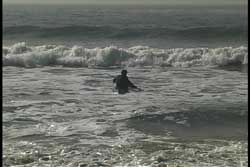 As this next whitewater wave gets near your kayaker you should
begin your forward stroke so you can counteract the force of the wave so
you do not get surfed backwards toward shore. You want to punch through
the wave without going too far forward. Paddle hard enough to hold your ground.
As this next whitewater wave gets near your kayaker you should
begin your forward stroke so you can counteract the force of the wave so
you do not get surfed backwards toward shore. You want to punch through
the wave without going too far forward. Paddle hard enough to hold your ground.
Remember to keep your kayak pointed towards the wave so it provides the least amount of resistance to the force of the water.
Again, as the wave passes by your kayak you want to chase it towards shore. Keep an eye out behind you for your landing spot and constantly monitor the next oncoming wave. This in out process will continue until you are on shore.
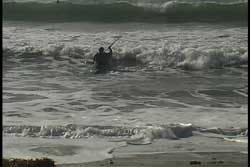 Hopefully you will chase your last wave in as it rushes up
on shore. The ideal landing is when you can ride up on shore on the back of
the wave. This way you are carried farther up the beach compliments of King
Neptune.
Hopefully you will chase your last wave in as it rushes up
on shore. The ideal landing is when you can ride up on shore on the back of
the wave. This way you are carried farther up the beach compliments of King
Neptune.
I have to say I find the area, where the water meets the shore, the most dangerous in the entire surf zone. Your kayak can touch bottom and you can end up spinning around. It is also possible to be turned sideways and get partially rolled over due to water moving up and down the beach. This is where damage to equipment and bodies usually takes place, if it occurs.
Landing with some speed helps with your control. Your goal is to back straight in.
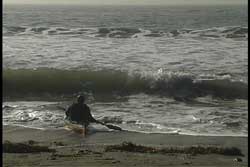 As your kayak touches bottom it is important that you dig
in to hold your position. You do not want to get floated back out to a possible
wave breaking on shore. Since most waves will be 8-12 seconds apart, you only
have that long to get out of your kayak before the next wave comes up on shore.
As your kayak touches bottom it is important that you dig
in to hold your position. You do not want to get floated back out to a possible
wave breaking on shore. Since most waves will be 8-12 seconds apart, you only
have that long to get out of your kayak before the next wave comes up on shore.
If the next surge of water coming up the beach is a bigger one than the one that got you to your present location, try to use it to ride farther up the beach to higher ground. Just push with your paddle and hand to get your kayak moving when that water reaches your boat.
If the surge is lower, you can use that extra time to get out of your kayak.
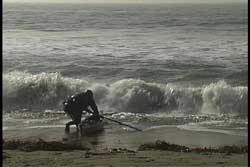 When you are sure your kayak has stopped moving I recommend
you get out as quickly as possible. Your goal is to be out of the kayak and
pulling it up the beach before the next wave comes up on the shore.
When you are sure your kayak has stopped moving I recommend
you get out as quickly as possible. Your goal is to be out of the kayak and
pulling it up the beach before the next wave comes up on the shore.
Practicing getting out quickly is a nice dry land drill. I have put friction tape on my deck, behind the back of my coaming (where I put my hands) to give me a better grip so I can exit quickly without my hands slipping off of the wet kayak. I usually toss my paddle way up on shore so I have hands free. Some of my friends like to put it under the deck shock cords. It is a personal choice.
Many of us move slowly when getting out of a kayak, especially if we have been sitting in the boat for a number of hours. Just something to keep in mind if you think you are going to jump right up and sprint above the water line with your kayak.
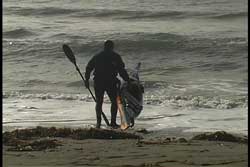 Once out of your kayak, grab the kayak and head up the beach
far above the high water line. That is when you can pat yourself on the back
for a successful landing.
Once out of your kayak, grab the kayak and head up the beach
far above the high water line. That is when you can pat yourself on the back
for a successful landing.
I have a couple of close paddling friends who just love the back in landing. One is a tour operator in Hawaii and another is an instructor in Maine. The conditions at either of these locations can get challenging and my friends still find the back in landing their landing method of choice.
As always, remember to wear your PFD and helmet when launching and landing through surf. Also, keep those elbows pointing down during any high braces. See USK article, "Side Surfing Control", in case you end up sideways.
Practice with small waves on sandy beaches without rocks. Don't forget to get the feel of the water before you play in it. See USK article, "TNT. When you practice this for the first time, it is wise to have a partner on the beach that can come out and help you if you need it. They can be more useful if they know how to swim with a paddle. See USK article, "Swim with a paddle".
I would be lying if I said you will not be capsizing in your learning process. That is why TNT and knowing how to swim and towing your kayak is so important. I suggest you plan on getting wet and dress properly for a long immersion if you had to swim the entire surf zone. If you keep at it, the rewards are worth it. It is such a powerful feeling when you can launch and land through a surf zone and feel in control. It actually becomes fun. See USK article, "Launching A Kayak Through Surf." Once you feel comfortable with launching and landing through a surf zone, then the next step is learning how to play in the surf zone.
As I have mentioned in previous articles, I recommend you practice with a plastic boat when you are first learning. If you have to use a fiberglass or kevlar kayak make sure it belongs to your soon to be ex-best friend. ;-)
Pictures seen above were taken from the Award Winning USK Video "ABC'S of the Surf Zone"
© Copyright USK